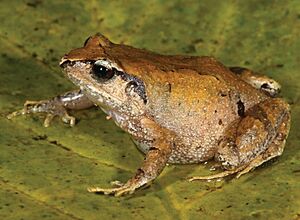Common squeaker facts for kids
Quick facts for kids Common squeaker |
|
|---|---|
 |
|
| Conservation status | |
| Scientific classification | |
| Synonyms | |
|
The Common Squeaker (scientific name: Arthroleptis stenodactylus) is a small frog. It's also known by other names like the dune squeaker or shovel-footed squeaker. These frogs are part of the Arthroleptidae family. They live across a large area of Africa, south of the Sahara Desert.
Contents
About the Common Squeaker Frog
The Common Squeaker was first described in 1893 by Georg Johann Pfeffer. This frog is found in many countries. Its range includes Kenya, Tanzania (including Zanzibar), Malawi, Mozambique, Zambia, and parts of the Democratic Republic of the Congo. You can also find it in Angola, Botswana, Zimbabwe, and northeastern South Africa.
Where the Common Squeaker Lives
The Common Squeaker lives in many different places. You can find it in forests, savannas, and even in areas near towns. It lives at heights up to 1,500 meters (about 4,900 feet) above sea level. These frogs usually hide among fallen leaves on the ground. They like damp spots where they can stay hidden.
How the Common Squeaker Reproduces
Unlike many frogs, the Common Squeaker does not need water for its eggs to hatch. This is called "direct development." The eggs are laid in hollows or burrows in damp earth. The tiny froglets hatch directly from the eggs, skipping the tadpole stage. This helps them live in drier places.
Conservation Status
The Common Squeaker is a very common frog species. Scientists do not believe it is currently facing any major threats. This means there are plenty of them in the wild.


